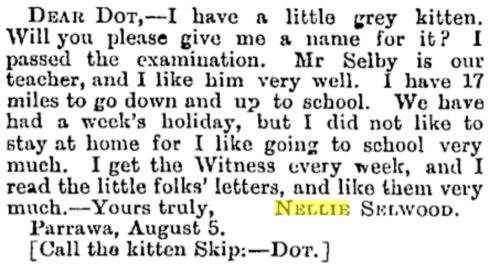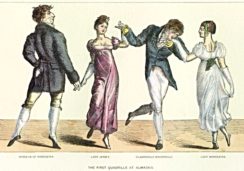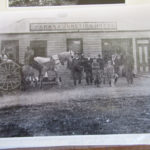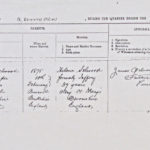Parawa is located 26 km north of Lumsden on the Invercargill (105 km away) to Kingston (35 km away) road and railway. It is also a junction of the road to the Nokomai Valley. It is the place where the Mataura River, with headwaters on the terminal moraine between Fairlight and Kingston, changes direction from heading south, through Garston and Athol, to heading east through the Nokomais.
The first evidence that James Selwood had moved to Parawa was a report in the Mataura Ensign on 10 June 1892 by their Lumsden correspondent: “The Oreti Licensing Court is to meet today at noon when the application for licenses for the year are to be considered. Rumour has it that under present management the police will report favourably on all the houses in the district. One application is to be in from the house formerly held by Mr Gibson, and at present tenanted by Mr Selwood. In consequence of the change of ownership the place has not been licensed for most of the past year.”
The Southland Times picks up the story on 14 June 1892: “James Selwood applied for an accommodation license for the Parrawa Hotel, but after hearing the police report the application was adjourned until the next quarterly meeting to enable the owner to put the premises in thorough repair.”
The first real confirmation that the Selwood family were living at Parawa, at that time called Parrawa, came from eleven-year-old daughter Helena (Nellie) Selwood. She wrote this to a “Dear Dot” children’s column published in the Otago Witness on 18 August 1892:

We owe it to Nellie Selwood, and the wonderful retrieval power of Papers Past, to confirm a few missing links in the Selwood story. First, the family had, by August 1892 and maybe much earlier, shifted 27 km (17 miles) north to Parawa. Secondly, she, and presumably all the school aged children, were travelling (by train) on the 54 km round trip to the Lumsden School. And thirdly, the teaching provided by Mr Selby of Lumsden School was so well liked by young Nellie that she preferred to be attending school than having an August school holiday!
The next insight into the life of the Selwoods at Parrawa again comes from one of the Selwood children writing a “Dear Dot” letter, this time nine-year-old Lily Selwood: “Dear Dot: I have never written to you before, but I always read the little folks’ letters in the Witness. I will tell you about my holidays. I went with a lady out to the Nokomai. We had to cross the Mataura seven or eight times, and also two very deep lagoons. The Nokomai was once a very busy township; there were lots of stores and 22 hotels and a great number of men digging for gold. It is now very quiet. There are not many diggers now, but farther up the creek there are lots of Chinamen digging. My mother and brother came out on horseback on Sunday to see the place, and we went all over the township and down the creek to see the big waterwheel that is now being put in order for an early start in the spring. They say there is a lot of gold underneath the creek bed, but they have to go very deep. There are hundreds of tunnels where the diggers have been working. There is plenty of fruit at the Nokomai, and the diggers have fruit gardens. The people I was stopping with were so kind to me, but after we had our tea and ma and my brother were going home I did not like to stop, so I went home too, and we went very fast. I did not like crossing the rivers very well, but mother said they were all right. – Yours truly Lily Selwood (aged 9 years) Junction Hotel, Parrawa, January 31.” (Published in the Otago Witness, 9 February 1893).
Again we learn more about Selwood Family life at Parawa. We can see that the children, Nellie and Lily, express themselves very well, maybe with a little parental and editorial support. The Selwoods were skilled horse riders and able to cross the Mataura River through the swift-flowing Nokomai Gorge. We also learn that there is a lot of fruit grown in the district, and this is significant in respect of a new occupation, chutney making, that mother Helena Selwood pursued.
The first intimation that chutney manufacture was underway in the Selwood household appeared in the Southland Times on 23 August 1893 in a rather strange way. The article headed “Spicey Chutney” discusses Indian chutney as an excellent condiment but that, “… by the time the piquant relish reaches New Zealand it has become costly and it is not an article in popular use”. The article speculated that, “… with the exception of spices all the ingredients of varied chutneys grow in our gardens, gooseberries, to wit, making an excellent foundation. But few housewives know of the delights of a good chutney”. The article goes on to tease us with these two sentences: “But there are some who do know how to compound a New Zealand chutney which would pass muster for the Bengal article anywhere; and one of these, located among the solitudes of Parrawa, has sent us a sample jar for which we return thanks and have nothing but praise. Indeed it is surprising that a little industry of the kind has not ere this been established, for chutney would be acceptable as an adjunct of the table to a far larger section of the community than, say, tomato sauce.”
There was no mention here that it was Helena Selwood of Parawa who was the chutney manufacturer, but it soon became obvious with this series of advertisements appearing in January 1894 editions of the Southland Times: “BOTTLES. BOTTLES. BOTTLES. Wanted to purchase any quantity of good clean Pickle Bottles. For price &c, apply to Mrs Jas. Selwood Junction Hotel, Parrawa.”
There does not appear to be any newspaper advertisements to promote Helena’s chutneys, but in the 4 September 1894 Mataura Ensign their Lumsden Correspondent reports: “I notice that the Parrawa chutney is securing itself a place amongst the different sauces manufactured in the colony. Mrs Selwood is now fairly embarked in this business and has every prospect of a large output during the coming season. The growth of this local industry means a demand for bottles, labels, corks, etc.; thus we are reminded of the mutual interdependence of modern society. I believe those who try Mrs Selwood’s Parrawa chutney will find it equal to any chutney in the market.”
At this time, 1894, Helena Selwood must have had her hands full. Besides running an accommodation house, making chutney, and raising a family of ten children she gained one addition. Hilda Florence (Tot) Selwood, their 11th and last child, was born at Parawa on 16 September 1894.
In 1893 New Zealand passed landmark Electoral Act legislation that all women had the right to vote in national parliamentary elections. New Zealand was the first self-governing country to do this, ahead of federal Australia (1902), United Kingdom (1918) and the United States (1920). James and Helena enrolled for the 1894 election in the Wallace Electorate. James was listed as: Selwood, James, Parrawa Hotel, Lumsden, and Helena as: Selwood, Helena, Parrawa, chutney maker, residential.
In other sections we take a closer look at the Parawa Junction Hotel, schooling and railways, Parawa property, the Nokomai goldfields, and James’ death in the period that the Selwood family was at Parawa. Here we will cover more specific Selwood family events.
A bit of excitement and danger occurred in what was referred to as a “wonderful sight” by the local reporter when a waterspout hit the Parawa district on Saturday 12 January 1895. A loud roaring sound louder than a heavy train crossing a bridge turned out to be a waterspout which came down the East Dome with terrific force, carrying trees, rocks and clay in its path. Mr Gibson, the owner of the large block of land on which the Parawa Junction Hotel is but a small part, suffered considerable crop damage and debris covering his land. The reporter goes on to say: “A young fellow, son of Mr Selwood, of the Parrawa Hotel, who was rabbiting in the vicinity, had a narrow escape. He ran back to his hut (which is now covered) to unloose his dogs when he saw the waterspout coming, and was just caught by the tail of the storm and covered with red clay, but fortunately sustained no injury. The railway lines were cleared in time for Monday morning’s trains to come through but it was expected the road would be impassable for a day or two.” (Mataura Ensign, 15 January 1895). That young Selwood fellow would have been Henry, aged 20. The next Selwood boy was Albert (Bertie) but he would only have been 11 years old and too young.
Living in the countryside, the Selwood family had less opportunity to partake in social functions compared to their compatriots in the larger towns, but they would have opportunity to attend school events, Lumsden Lodge events, and race meetings when special trains were laid on. There were also social occasions in their hotel, sometimes raucous and almost riotous, especially when the Nokomai miners came to town.
There is a nice report in the Mataura Ensign of 5 September 1895 of a quadrille ball held at the local Athol School, three miles up the road. The Quadrille Assembly is of French origin with an American square dance influence and was popular in New Zealand in the latter half of the 19th century. “Music was supplied by Messrs E. Soper (violin) and H. Soper (accordion).” Some of the dresses worn were described as follows: “Miss Selwood, light blue sateen dress over skirt, black fisher’s net bodice, rimmed with lace etc. Miss Bessie Selwood, shot silk bodice skirt of white over fishers net.” I suspect the unnamed Selwood girl would be Edith, the eldest daughter, aged 18, in attendance with Bessie, the second eldest, aged 16 at that time.

In 1899 there was some excitement in the Parawa district as a result of a bird discovery by two of the Selwood boys. To quote the Otago Witness (31 August 1899): “ Somewhat of a rare avis was captured at the Parrawa Hotel premises a few days ago, and so far nobody appears to have been able to fix its identity.

Concerning this matter a Parrawa correspondent writes: “There is in Mrs Selwood’s possession, at the Parrawa Hotel, what is considered to be a very rare specimen of a bird. It has been inspected by a large number of people, who acknowledge they have never seen one of its kind before. It is not quite as large as a Maori hen, but it is very pretty, and it is thriving well in its present state of captivity.” Another Parrawa correspondent states: “A strange bird was captured by Mrs Selwood’s two little boys, near the Parrawa Hotel, recently. It resembles a Maori hen in every particular (way) save its breast is beautifully marked, but the bird is only half, or scarcely half, the size of a weka, the actions of which it imitates in every way. No one about here, so far as I can learn, has seen anything like this strange bird.” (Mataura Ensign).
With my referral to, and help of, specialists from Te Papa National Museum and the University of Otago, it is probable that the bird was a banded rail (or mioweka). This bird is related to and smaller than the weka. It is an uncommon species and declining in numbers. In the South Island there are now small numbers limited to the Nelson and Marlborough regions. The banded rails are reluctant but strong fliers and can travel considerable distances. The Parawa specimen probably flew from the Titi or Mutton-bird Islands off the coast of Stewart Island.
In the next section, the Parawa Junction Hotel, we look at the hotel and life within. It was during this period, in the latter part of the 1890s, that James Selwood deteriorated in health and died in April 1899. See section James Selwood Death.
After his death, with still nine children in tow, Helena looked to reposition her life and decided to move to Kingston.
A special farewell was given to Helena Selwood and family in July 1901. The Mataura Ensign sums up the occasion as follows:
“Presentation at Parrawa: On Saturday evening a large gathering assembled at Mrs Selwood’s hotel, Parrawa, for the purpose of presenting Mrs Selwood with a very handsome illuminated address, which does no more than express the regret of those who were so willing to show their appreciation of her worth. Mrs Selwood had been a resident of Parrawa for nine years, and during that period she has gained the esteem of all with whom she came in contact. At 6 o’clock a large crowd sat down to a sumptuous spread, to which everyone did justice, and after which the room was cleared, and a very enjoyable evening was spent in dancing, songs, etc. During the proceedings Mr Price presented Mrs Selwood with the testimonial she so well deserves, making a few brief remarks and wishing her every prosperity in her sojourn, also wishing her family every success and happiness.
“Mr Jas. Mulholland replied on behalf of Mrs Selwood, thanking the people for the respect and kindness they had shown towards herself and family by presenting her with such a beautiful and unexpected gift. She hoped it would be the means of keeping her memory fresh with her very kind friends, and that she should meet them all again.
“About 11 o’clock tea was handed round, after which all joined in singing ‘Auld Lang Syne’, also giving Mrs Selwood and family three hearty cheers. Mrs Selwood left the Parrawa Hotel yesterday (Wednesday).” Mataura Ensign, 18 July 1901.






